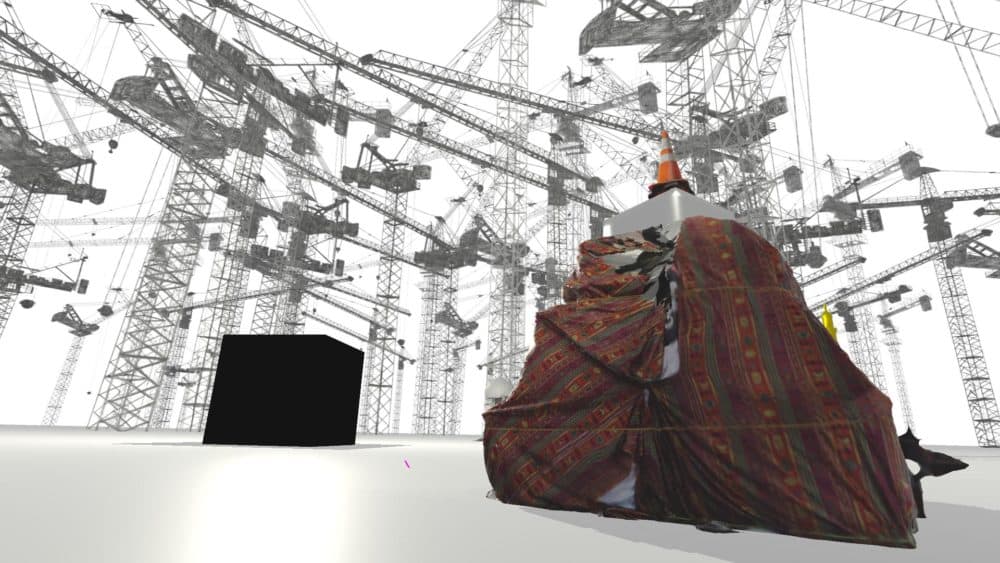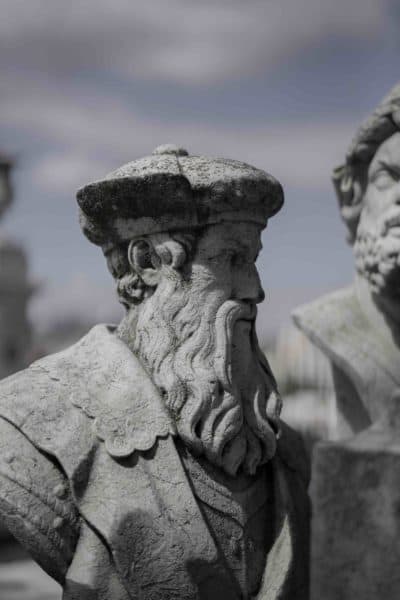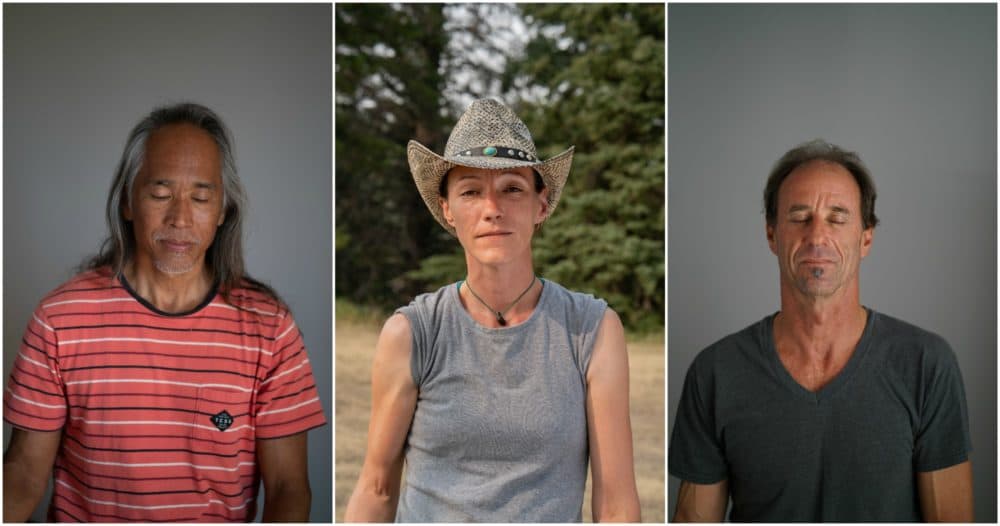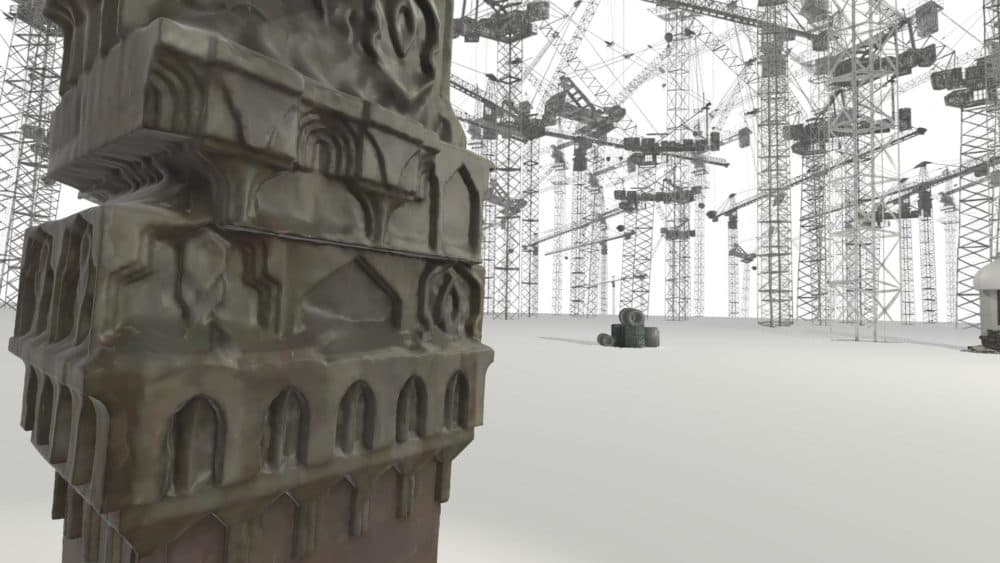Advertisement
'The City Inside Us' Exhibition Takes On The Hidden Narrative Of Places In Transition

How many times do you need to return to a place to really understand it? And when you do return, again and again, what do you find?
These are the kinds of questions we ponder when we travel the world, or even just across town. Either way, we are amazed and dazed by the precipitous changes we see around us.
“The City Inside Us,” a two-person exhibit on view at South Boston’s Distillery Gallery from Feb. 16 to March 17, takes on the theme of history, memory and place as artists Jose Ferreira and Asma Kazmi offer a sort of anthropological view of cities, spaces, and the people that populate them. Encompassing both virtual reality and photography, the exhibit offers visitors fragments of an enigmatic puzzle revolving around changing topography and what it has to say about who we are and what we value.

Ferreira offers portraits of people juxtaposed with a photo of a building fragment interspersed with text passages. The portraits, measuring about 24-by-36 inches, are the sort of standard issue mug shots you might encounter on any passport, although some of the people photographed keep their eyes closed. These are people Ferreira has met during his time in Hawaii, where he is an assistant professor of art at the University of Hawai'i at Mānoa. They seem disparate and odd when set next to the photograph of a statue, and strange as well when shown along with narrative text describing the flora and fauna of Hawaii, or the work life and consumption habits of unidentified characters. Who are these people and what is the connection?
As someone who was born in Mozambique and who grew up in South Africa, Ferreira says he brings his own memories and history to everything he encounters. His photography is meant to acknowledge his own biases and emphasize that there is always much more than meets the eye. He has included text — something between a story and song lyrics — meant to poetically allude to the unseen.
“There are hidden narratives within these things that we are looking at that we may not be seeing,” he says.
Hawaii is particularly interesting in this regard, he says. While most of us are familiar with the islands as a tropical holiday paradise, Hawaii has a complex history involving European exploration, settlement by American Christian missionaries who would attempt to convert the indigenous populace, as well as waves of immigration from Japan, China and the Philippines.
“Underneath that, there's just a lot more to the place,” says Ferreira. “Obviously, a lot of places are like that — not just in the U.S., but globally. There's a sub-narrative to the main narrative. There's a history underlying so much, and I'm fascinated by that. It's like an emotional geography.”

Ferreira has taken on many locales in the course of his art career. He has photographed the salt mines of Brazil, swept away his own footprints in Mozambique in a performance piece entitled “Sweeping Maputo,” broadcast anguished screams in the northern suburbs of Johannesburg as part of a conceptual piece. To a large extent, Ferreira’s process involves the simple act of walking. He has walked across parts of the United States, South Africa and Europe. In June, he is planning a walking trip across parts of Brazil. Along the way, he talks to people and takes pictures. He makes repeated visits to places he visits, to map changes and avoid what he calls "dry season" bias.
“I like to think of my research as going back multiple times, taking photographs during different periods of the year, becoming these layers of history so that I can uncover this as I go along,” he says. “That's the premise for a lot of the work.”
Asma Kazmi, also investigates the idea of memory and place, but in a completely different way. She offers two different pieces: "Cranes and Cube" and "Indian Mangoes by the Red Sea," interweaving virtual reality objects with drawings, text and video and sculptures. She is most concerned with how cities change, pushing certain people out while welcoming others in. An assistant professor in the Department of Art Practice at UC Berkeley, Kazmi experiences these shifts in the Bay Area, but she sees them as well everywhere else — not only in Boston, where she attended MassArt as an undergrad, but also in her native Karachi, and in the places she has traveled, including Mecca in Saudi Arabia. In her virtual reality piece, “Cranes and Cube,” viewers are invited to enter a virtual Mecca, populated not just with architectural fragments, but with construction cranes and cones reflecting the development that has gone on in the city in recent years.
“I'm interested in that sort of juxtaposition of religiosity as well as this kind of real estate and commercialism,” she says.

Kazmi took hundreds of pictures of various architectural elements in Mecca and Jeddah and collapsed them into strange assemblages and objects that are meant to feel dreamlike and surreal. It is Kazmi's reinterpretation of a city whose buildings were influenced by the traditions of migrant laborers from India, Morocco, Turkey and Iran but now feels more like an anonymous construction zone.
“These buildings brought together all these architectural influences from all over the world, and that’s what we've lost by having lost all these buildings.”
Kazmi says she has nothing against change in cities, but it’s the way things change that is worrying.
“It tells you something about the values of a culture and a society,” she says. “For instance, in San Francisco, the way the city has changed, it caters to a very specific kind of person who is tied to the tech industry.”
Meanwhile, she says, hotel rooms in Mecca now charge thousands of dollars a night, far beyond the means of most Muslims making the pilgrimage to the city each year.
“It's not that I'm lamenting change, but I'm critiquing how the change is happening in an unconsidered way, where lots of people have been marginalized in the process.”
“The City Inside Us” is not the first time Kazmi and Ferreira have shown together. They most recently combined efforts in another version of this show “Hiding in Plain Sight” at the University of Hawai'i. Both are research-oriented artists who are as much about ideas as images, and who have found commonality in their art practice through non-linear approaches to telling a story. The Distillery Gallery seemed the perfect backdrop to explore their ideas around memory, place and change, since South Boston itself has undergone such rapid change in recent years.
“That neighborhood has so dramatically changed since I had last seen it,” says Kazmi. “So even though I'm talking about a very specific place in the world, namely Mecca and Saudi Arabia, I'm interested in how some of the same ideas emerge in other places.”
“The City Inside Us” is on view at The Distillery Gallery, Feb. 16 to March 17. Opening reception is Saturday, Feb. 16, from 7 to 10 p.m. The gallery is located at 516 East 2nd St., South Boston.
